
Well, well, well. Look who decided to poke their head into the rabbit hole of AI copywriting.
As you stare down into the abyss, a faint grin creeps across your face. Could this be the magic bullet you’ve been searching for? A way to effortlessly churn out piles of high-quality blog posts day after day?
Let me burst that bubble real quick: AI is no silver bullet. But it can be an incredibly useful tool for supercharging your blogging efforts.
In this extensive guide, I’ll decode everything you need to know to harness the power of AI copywriting as a blogger.
We’ll cover:
- What is AI copywriting?
- Common frustrations it solves
- Technical capabilities
- Practical applications
- Risks and limitations
- The future outlook
- And more
By the end, you’ll have a clear understanding of what AI copywriting is, what it can (and can’t) do for your blog, and how to put it to work effectively.
So strap on your propeller hat and let’s take the plunge!
What is AI Copywriting?
AI copywriting uses artificial intelligence to automate parts of the content creation process that previously required human copywriters.
At a basic level, AI copywriting tools allow you to describe content you want to generate, and will produce a draft matching your instructions.
For example, you could tell the AI:
“Write a 300 word blog post about the benefits of meditation, aimed at stressed entrepreneurs.”
The AI will then churn out a unique 300 word article about that topic, like this one:

This can save bloggers immense time and effort compared to writing from scratch. The AI effectively acts as an intelligent “co-writer.”
Current AI copywriting tools are powered by large neural networks trained on vast datasets of text. This allows them to generate human-like content within defined parameters.
Let’s dig into some common pain points AI copywriting alleviates.
Frustrations AI Copywriting Solves
“Ugh, I’m drawing a total blank…I have no idea what to write about today.”
If that feeling resonates, you’re not alone. Most bloggers struggle with writer’s block. Creative ruts suck.
AI can help get those creative juices flowing again by providing prompt ideas or expanding on a seed thought.
“There’s just not enough hours in the day to produce all the content I need.”
Quality content takes significant time. AI speeds up drafting so you can crank out more posts.
“I’m just sick of writing the same types of articles over and over.”
Repeating similar content gets old fast. AI gives you an endless fount of fresh perspectives to pull from.
“Writing great headlines and hooks is so hard for me.”
Coming up with compelling titles and intros is a skill. AI can provide options to choose from or refine.
“I wish I could test 10 different versions to see which converts best.”
Testing content variations is powerful but usually impractical. AI makes it easy to produce multiple versions.
In summary, AI alleviates:
- Writer’s block and lack of ideas
- Slow writing speed
- Repetitive content
- Difficulty hooking readers
- Impracticality of testing variations
Now let’s explore some of the technical capabilities that make this possible.
AI Copywriting Capabilities
Modern AI copywriting tools. like Claude or ChatGPT can generate content with different degrees of human guidance. Key capabilities include:
Completing partial text — The AI will finish a sentence, paragraph, or section of text provided.
“Write an inspiring conclusion for this blog post introduction…”
Let’s actually do this live:
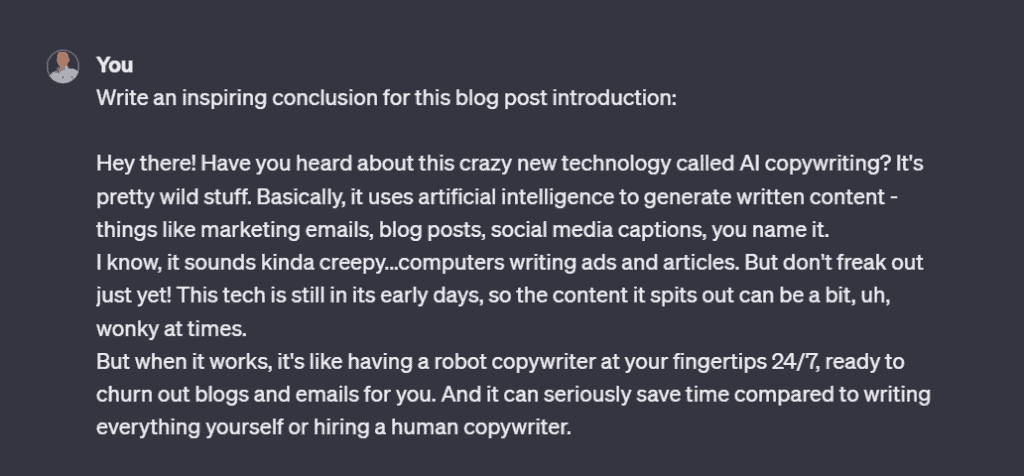
ChatGPT’s output:

Not bad, right?
Expanding outline — Give the AI an outline and it will flesh out each section.
Title: Four Ways to Simplify Your Morning Routine
- Introduction
- Plan ahead
- Streamline your space
- Automate what you can
- Conclusion
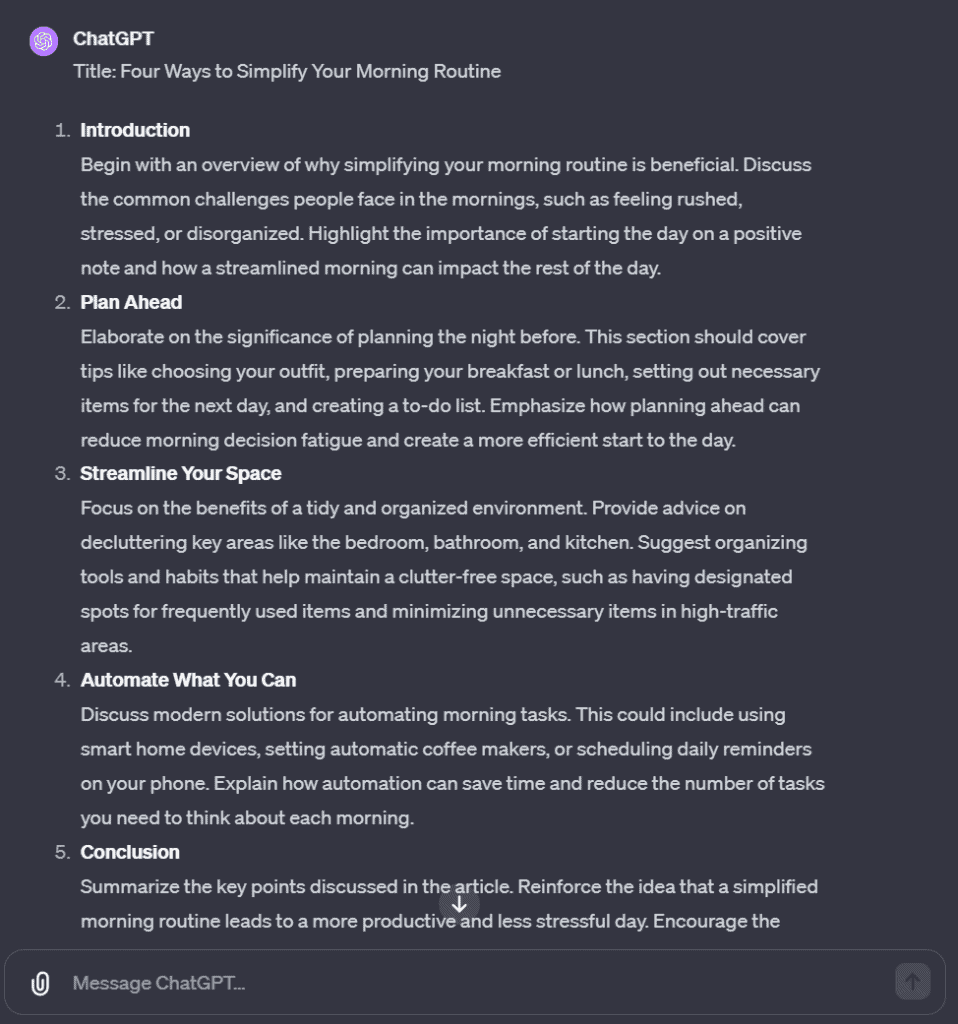
Generating from scratch — Provide a topic, tone guidelines, length, etc. and the AI will create a draft.
“Write a 500 word blog post offering first-time home buying tips for young couples.”
And we get:

Rewriting/Editing existing drafts — The AI can refine and improve content you’ve already created.
“Revise this paragraph to be more convincing and use more vivid language.”
Let’s give ChatGPT a very formal paragraph about AI copywriting, generated by Perplexity:

Now, we’ll give ChatGPT this very content:
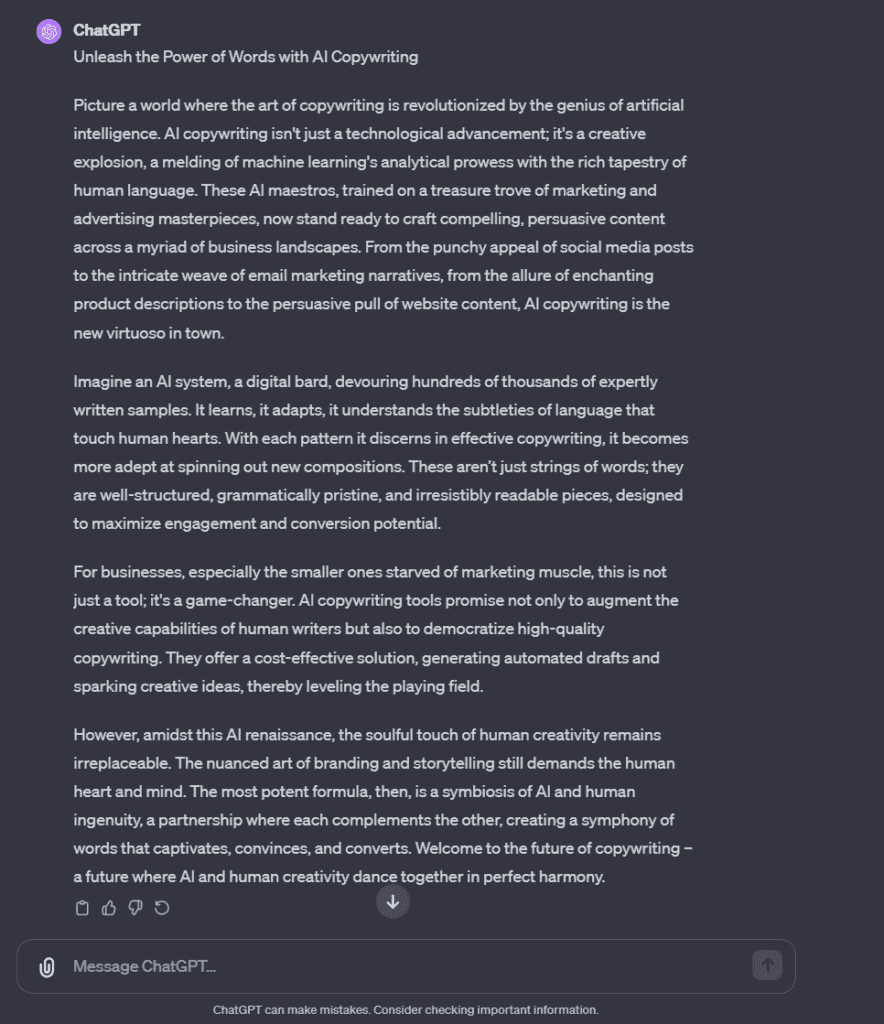
I hope you see the difference.
Humanizing AI content — yes, with my custom GPT you can even do this.
Let’s give my AI humanizer the above content and see what happens:
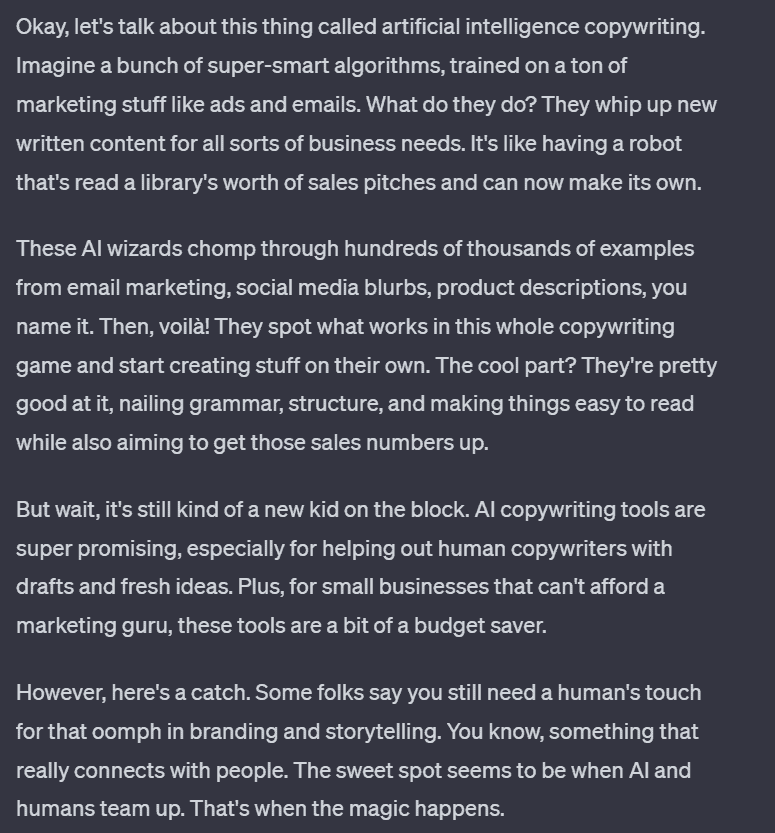
Let’s check the piece with Originality.ai (the best AI detector, I must say):
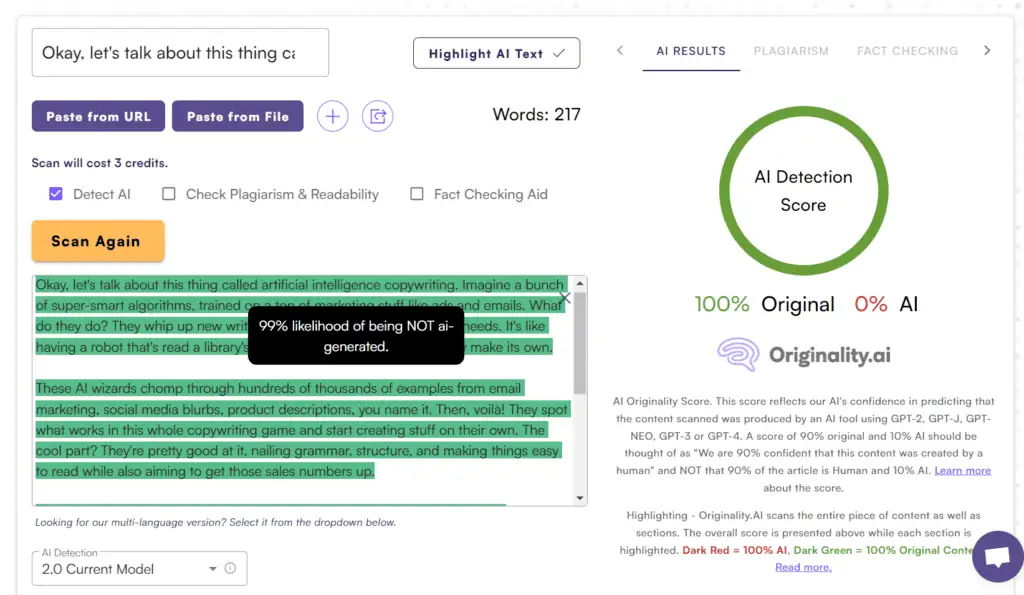
Isn’t that great?
Brainstorming related ideas — Describe a topic and the AI will suggest angles to write about.
“Give me 10 blog headline ideas related to sustainable fashion.”
Let’s use Claude, for a change:

Actually, I like Claude outputs more, but ChatGPT does a much better job in some ways.
As you can see, AI copywriting tools provide an end-to-end solution for drafting, expanding, and refining content.
This opens up a world of possibilities for bloggers to tap into. Let’s explore some of the most practical applications.
How Bloggers Can Apply AI Copywriting
While AI copywriting capabilities are impressive, implementing it effectively requires strategy. Used well, it can amplify a blogger’s output dramatically. Used poorly, it leads to dreck.
Here are some of the most effective ways for bloggers to leverage AI copywriting tools (beginner’s level):
1. Get Unstuck From Writer’s Block
Even the best bloggers get stuck sometimes. Instead of staring at a blinking cursor for hours, use AI to get the ball rolling again.
Describe the core topic, target audience, tone and anything else relevant. The AI will suggest angles to write from and content formats that may inspire you.
For example:
“Propose 10 entertaining blog post ideas about embarrassing travel mishaps aimed at budget backpackers.”
And here’s what Claude gave to me:

Review the ideas and expand on any with promise. The AI provides that initial spark to build from.
2. Produce Multiple Variations
One of the most powerful applications is using AI to effortlessly generate multiple variations of headlines, openings, sections, etc.
Then you can manually review and stitch together the best parts from each version.
For example:
“Give me 3 potential opening paragraphs for a post about morning routines for busy moms. Make each one unique.”
Claude’s output:
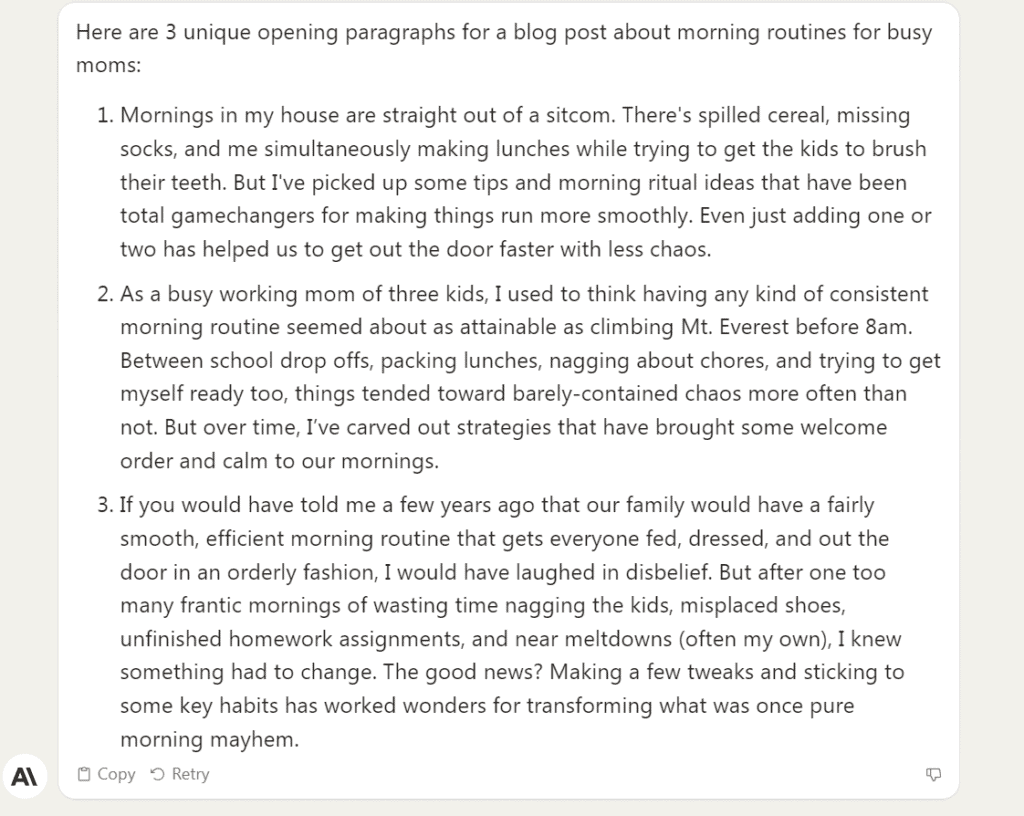
This allows rapid testing of different content permutations that resonate best with readers.
3. Revise and Refine Drafts
Even if you manually write a complete draft, AI can help refine and enhance it.
Fix fuzzy sections, expand thin areas, adjust tone, improve flow — the possibilities are vast. Think of it like an intelligent editor.
Improving drafts with AI allows bloggers to maximize the quality of their finished content in less time.
4. Research Content Ideas and Outlines
AI tools excel at digesting information and summarizing key points on a topic. Set the AI loose to research and propose content ideas and outlines.
For example:
“Read top 10 results from Google about vegetarianism. Then give me a unique and original outline for a blog post titled ’10 Benefits of Going Vegetarian’”
To use web results opt for ChatGPT Plus or Perplexity — Claude is not internet friendly at the moment.
So, here is the ChatGPT’s output for the above prompt:

The picture doesn’t show all 10 titles, but I think the idea is clear.
The AI will rapidly process the source materials and provide a custom outline incorporating the most salient points.
This can radically accelerate your content research process.
5. Bulk Generate Drafts
Once you’re comfortable with the technology, consider using AI to mass produce initial drafts of multiple posts simultaneously.
For instance, you could generate 20 draft blog posts in different niches to jumpstart your output. Review, refine, and finalize the ones worth publishing.
You can try Agility Writer for writing long-form drafts. By the way Agility is one of the best GPT-4-powered AI writing tools.
Think of AI as an intelligent intern producing the first version for you to build on rather than writing from scratch.
Ok, by now your mind is probably swirling with ideas on how to put AI copywriting to work for your blog. Slow down, speed racer! Let’s talk about managing risks.
Risk Factors to Consider
As transformative as AI writing tools are, they come with risks like any technology. Being aware of the limitations and mitigating risks is important for effective use.
Lack of Human Touch
The most obvious risk is that AI-generated content may lack the human touch of writing produced manually. It often has a generic quality and may fail to connect emotionally.
Mitigate by using AI as a “co-writer” to get drafts started then refine and personalize the content before publishing. Don’t entirely outsource writing to the AI.
Plagiarism Concerns
Some fear AI could produce plagiarised content by over-sampling original sources. However, modern AI models create new narratives rather than copy-pasting.
Mitigate by providing limited source material, never publishing AI drafts verbatim, and double checking for any plagiarized passages missed.
I use Grammarly for this purpose, like this:
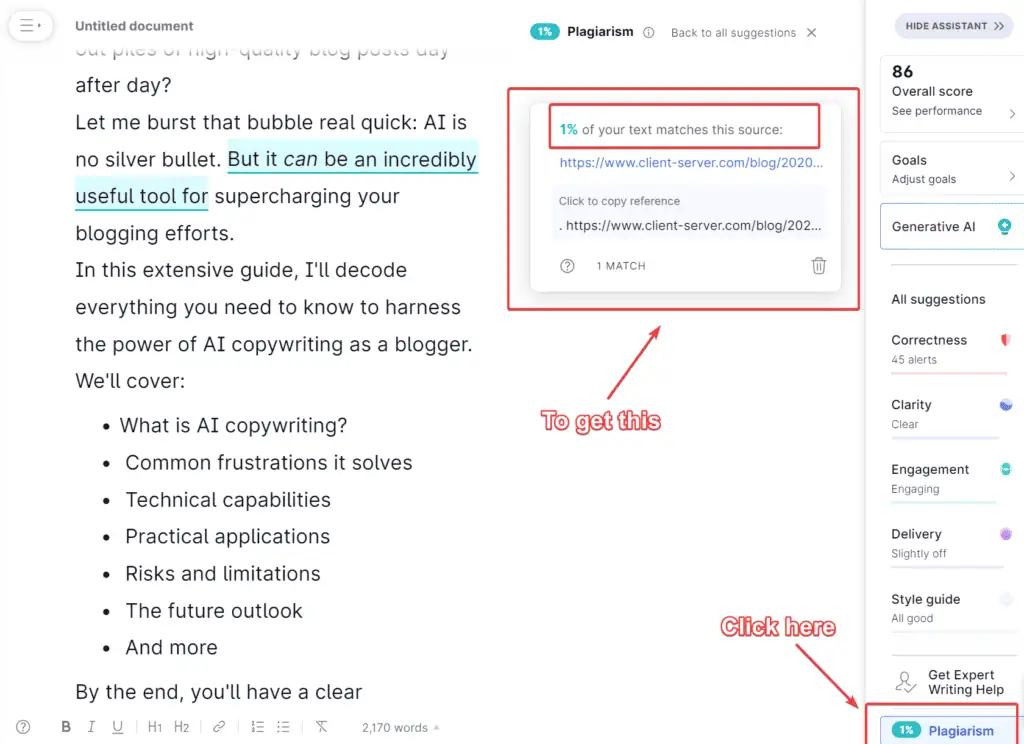
Formulaic Output
Depending on the input prompts, AI can yield somewhat formulaic or repetitive content. Too narrow a prompt scope limits originality.
Mitigate by providing broad topic areas rather than detailed instructions. Then refine and adapt the drafts to avoid repetitiveness.
Imperfect Readability
While AI writing quality has improved tremendously, it still often lacks the refinement and flow of human copy. Glaring issues may remain.
Mitigate by manually review drafts closely for problems before publishing.
Treat AI as an assistant rather than a complete replacement for writing skill.
The risks above must be balanced with the huge potential upsides. But misuse could backfire, so educate yourself and proceed thoughtfully.
Now that we’ve covered the key basics in detail, let’s zoom out and examine the bigger picture future for AI-powered content creation.
The Future of AI Copywriting
Like it or not, AI-generated content is coming fast. As conversational models like ChatGPT, Claude, Copy.ai, Japser, and many more gain mainstream adoption, dependence on them for drafting content will likely accelerate.
What does this mean for the future of blogging and copywriting?
Proliferation of AI Content Creation
Across industries, reliance on AI tools to produce or augment content will grow exponentially in coming years. Forward-thinking bloggers should be at the forefront of this curve.
The time and thought investment required to skillfully guide AI copywriting will also shrink as prompt engineering techniques improve.
Escalating Audience Expectations
As AI copy gets better, engagement thresholds will rise. Audiences will expect valuable personalized content tailored exactly to their needs and interests.
AI allows bloggers to scale the production of ultra-targeted content for different segments. Those who leverage it will gain a competitive edge.
Increasing Legal/Ethical Scrutiny
With AI playing a bigger content role, best practices for proper attribution and preventing plagiarism will draw more attention. Copyright issues may also arise needing resolution.
Bloggers should stay abreast of emerging regulations and disclosure requirements related to AI-generated or AI-assisted writing.
Job Loss Fears Overblown
While parts of the copywriting field will be automated, AI should not be viewed as a threat. Savvy bloggers will use it to augment creativity rather than replace writers.
The enhanced productivity enabled by AI writing tools can actually create new blogging jobs to fuel greater content volume and personalization.
Uneven Access Unless Democratized
If the best AI copywriting tools remain walled off by high costs or exclusivity, it may disproportionately benefit those with access and widen competitive divides.
Ideally AI generation platforms will open access and capabilities more equally to empower bloggers at all levels. Democratization must remain a priority.
So in summary, the AI copywriting genie is out of the bottle for good.
The winning mindset is not resisting this change, but embracing it. Use it don’t lose it. Or be ready to get left behind.
Key Takeaways and Next Steps
We’ve covered a ton of ground exploring the ins and outs of AI copywriting. Let’s recap the key points:
- AI copywriting uses AI to automate parts of the content creation process providing efficiency and idea generation.
- It relieves common frustrations like writer’s block and slow drafting.
- Key capabilities include completing partial text, expanding outlines, generating from scratch, rewriting, and brainstorming.
- Smart ways for bloggers to use AI copywriting include getting unstuck from writer’s block, producing variations for testing, revising drafts, researching content faster, and generating initial drafts.
- Risks exist around lack of human touch, plagiarism, repetitive output, and imperfect readability if the technology is not used judiciously.
- AI copywriting will become widespread in coming years across industries including blogging, escalating audience expectations.
- Savvy bloggers should thoughtfully explore incorporating AI copywriting now to gain a strategic edge.
So in closing, don’t let fear or perfectionism hold you back. Dive in, start experimenting, and learn-as-you-go.
Beginning to use AI copywriting — even imperfectly — is better than being paralyzed by overwhelm.
The key is starting. Pick one simple application, like turning a blog post headline into a draft. Then build up your skills and comfort incrementally.
Soon you’ll be surfing the AI wave to take your content to the next level. I can’t promise it’ll be easy. But it will be worth it!
Now go wow the blogging world.

About the Author
Meet Alex Kosch, your go-to buddy for all things AI! Join our friendly chats on discovering and mastering AI tools, while we navigate this fascinating tech world with laughter, relatable stories, and genuine insights. Welcome aboard!
KEEP READING, MY FRIEND






